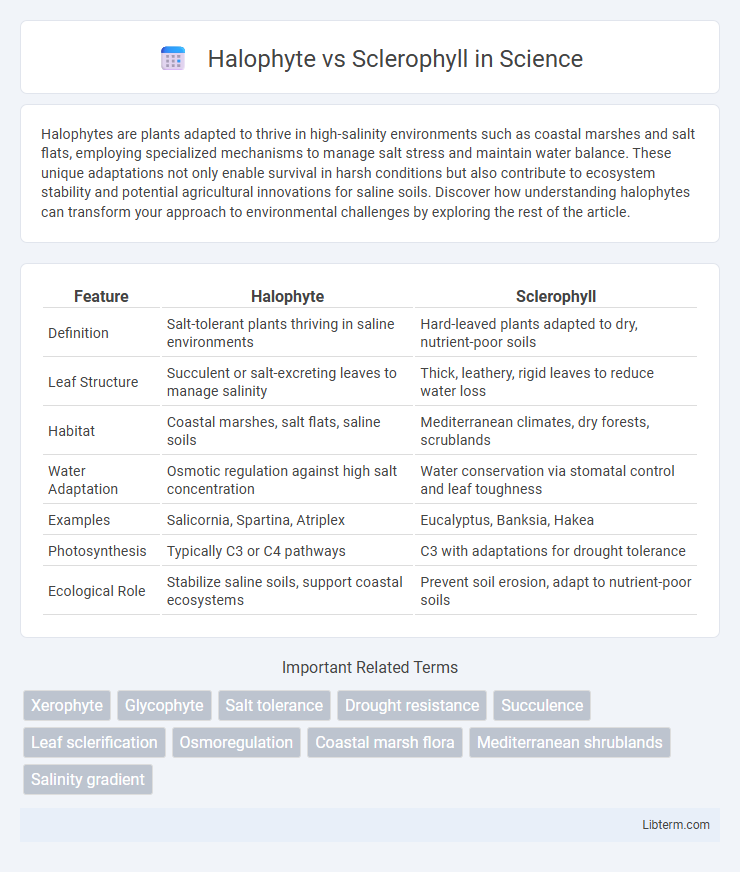Halophytes are plants adapted to thrive in high-salinity environments such as coastal marshes and salt flats, employing specialized mechanisms to manage salt stress and maintain water balance. These unique adaptations not only enable survival in harsh conditions but also contribute to ecosystem stability and potential agricultural innovations for saline soils. Discover how understanding halophytes can transform your approach to environmental challenges by exploring the rest of the article.
Table of Comparison
| Feature | Halophyte | Sclerophyll |
|---|---|---|
| Definition | Salt-tolerant plants thriving in saline environments | Hard-leaved plants adapted to dry, nutrient-poor soils |
| Leaf Structure | Succulent or salt-excreting leaves to manage salinity | Thick, leathery, rigid leaves to reduce water loss |
| Habitat | Coastal marshes, salt flats, saline soils | Mediterranean climates, dry forests, scrublands |
| Water Adaptation | Osmotic regulation against high salt concentration | Water conservation via stomatal control and leaf toughness |
| Examples | Salicornia, Spartina, Atriplex | Eucalyptus, Banksia, Hakea |
| Photosynthesis | Typically C3 or C4 pathways | C3 with adaptations for drought tolerance |
| Ecological Role | Stabilize saline soils, support coastal ecosystems | Prevent soil erosion, adapt to nutrient-poor soils |
Introduction to Halophytes and Sclerophylls
Halophytes are plants adapted to thrive in saline environments such as salt marshes and coastal regions, exhibiting specialized salt tolerance mechanisms like salt excretion and succulence. Sclerophylls possess hard, leathery leaves adapted to dry, nutrient-poor soils typically found in Mediterranean climates and sclerophyll forests. Both plant types demonstrate unique physiological adaptations that allow survival under extreme environmental stress, with halophytes focusing on salt management and sclerophylls on water conservation.
Defining Halophytes: Salt-Loving Survivors
Halophytes are salt-tolerant plants adapted to thrive in high-salinity environments such as coastal marshes and saline soils, showcasing specialized physiological mechanisms like salt secretion or compartmentalization. These resilient plants contrast with sclerophylls, which are characterized by hard, leathery leaves adapted primarily to dry, nutrient-poor conditions rather than saline stress. Understanding halophytes' unique adaptations offers insights into salt tolerance strategies crucial for agriculture in saline-prone regions.
Understanding Sclerophylls: Tough-Leaved Plants
Sclerophylls are tough-leaved plants characterized by thick, leathery foliage adapted to conserve water and withstand nutrient-poor soils typically found in Mediterranean and dry climates. These plants possess hardened, sclerified cell walls with high cellulose and lignin content, which reduce water loss and provide resistance against herbivory and environmental stress. Unlike halophytes that thrive in saline environments by specialized salt excretion mechanisms, sclerophylls rely primarily on leaf structural adaptations to survive drought and nutrient scarcity.
Habitat Differences: Where Halophytes and Sclerophylls Thrive
Halophytes thrive in saline environments such as coastal marshes, salt flats, and mangrove swamps, where high salt concentrations limit plant diversity. Sclerophylls are typically found in nutrient-poor, Mediterranean-type climates with dry summers and wet winters, characterized by hard, leathery leaves adapted to conserve water. These distinct habitats drive the unique adaptations of halophytes for salt tolerance and sclerophylls for drought resistance.
Adaptations to Stress: Salinity vs. Drought
Halophytes exhibit specialized adaptations such as salt glands, succulence, and ion compartmentalization to manage high salinity environments, enabling them to maintain osmotic balance and avoid salt toxicity. Sclerophyll plants develop tough, leathery leaves with thick cuticles and reduced stomatal density, enhancing water retention and minimizing transpiration under drought stress. These distinct physiological and structural traits allow halophytes to thrive in saline habitats while sclerophylls are optimized for survival in arid, nutrient-poor conditions.
Morphological Features of Halophytes
Halophytes exhibit specialized morphological features such as succulent leaves and stems that store water, thick cuticles to reduce water loss, and salt glands or bladders for excreting excess salt, enabling them to thrive in saline environments. Their root systems are often extensive and adapted to stabilize plants in saline or waterlogged soils. In contrast, sclerophyll plants possess hard, leathery leaves with thick cuticles primarily adapted for drought tolerance rather than salt regulation.
Structural Traits of Sclerophylls
Sclerophylls exhibit thick, tough leaves with a high density of sclerenchyma cells, providing mechanical support and reducing water loss. Their cuticles are often thick and waxy, while stomatal density is usually low to limit transpiration in arid environments. These structural adaptations allow sclerophyllous plants to thrive in nutrient-poor, dry soils, enhancing drought resistance and longevity.
Ecological Roles and Importance
Halophytes thrive in saline environments, playing a crucial ecological role by stabilizing coastal and salt-affected soils while providing habitat for specialized fauna and contributing to nutrient cycling in harsh conditions. Sclerophyll plants, characterized by their tough, leathery leaves, dominate nutrient-poor, dry ecosystems such as Mediterranean forests, enhancing soil conservation and supporting biodiversity by offering food and shelter to various insects and herbivores. Both plant types are vital for maintaining ecosystem resilience and productivity in challenging habitats, underpinning ecological balance and supporting diverse biological communities.
Key Examples of Halophyte and Sclerophyll Species
Salicornia and Spartina exemplify halophyte species thriving in saline environments with specialized salt-tolerant adaptations. Eucalyptus and Quercus represent sclerophyll species characterized by hard, leathery leaves adapted for water conservation in nutrient-poor soils. These distinctive plants highlight evolutionary strategies for survival in extreme habitats such as salt marshes and dry, rocky landscapes.
Halophyte vs. Sclerophyll: Evolutionary Perspectives
Halophytes evolved specialized salt tolerance mechanisms to survive in saline environments, demonstrating adaptations such as salt excretion and succulence, which contrast with sclerophylls that developed thick, leathery leaves to reduce water loss in nutrient-poor, dry habitats. The evolutionary trajectory of halophytes highlights selective pressure from high salinity, whereas sclerophylls reflect adaptations to drought and low soil fertility. Both plant types exhibit distinct morphological and physiological traits driven by their unique ecological niches, illustrating convergent evolution toward stress endurance in contrasting environmental conditions.
Halophyte Infographic

 libterm.com
libterm.com